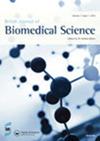一例骨髓衰竭综合征患者MYSM1基因的新型复合杂合突变
IF 4.6
4区 医学
Q2 MEDICAL LABORATORY TECHNOLOGY
British Journal of Biomedical Science
Pub Date : 2021-10-01
Epub Date: 2021-03-19
DOI:10.1080/09674845.2021.1894706
引用次数: 2
摘要
本文章由计算机程序翻译,如有差异,请以英文原文为准。
A novel compound heterozygous mutation of MYSM1 gene in a patient with bone marrow failure syndrome 4.
Myb-like swirm and MPN domains 1 (MYSM1) is a gene encoding histone H2A deubiquitinase, which can regulate the expression of transcription factor related genes and involve the immune and hematopoietic system. Homozygous and missense mutations of MYSM1 lead to immune deficiency, mainly manifested by B cell deficiency and T cell reduction. Bone marrow failure syndrome 4 (BMFS 4) is an autosomal recessive disorder characterized by early-onset anemia, leukopenia, and decreased B cells, resulting in an increased susceptibility to infection. Here, we report a 2-month-old girl with a highly suspected BMFS due to the clinical characteristics of recurrent, severe anemia, intermittent thrombocytopenia, polydactylism, and slow growth. Whole exome sequencing identified a compound heterozygous mutation with c.1607_c.1611delAAGAG (exon 12) from the mother and c.1432C>T (exon 10) from the father in the girl. We suggest that c.1607_c.1611delAAGAG is a newly discovered pathogenic mutation. In addition, the mutation c.1432C>T (exon 10), rs748065332 is a truncated mutation (p.R478*,351), which is also reported for the first time. This case expands the phenotypic spectrum of BMSF4 and is helpful to explore the significance of BMFS4 gene detection in children with bone marrow failure syndrome.
求助全文
通过发布文献求助,成功后即可免费获取论文全文。
去求助
来源期刊

British Journal of Biomedical Science
医学-医学实验技术
CiteScore
4.40
自引率
15.80%
发文量
29
审稿时长
>12 weeks
期刊介绍:
The British Journal of Biomedical Science is committed to publishing high quality original research that represents a clear advance in the practice of biomedical science, and reviews that summarise recent advances in the field of biomedical science. The overall aim of the Journal is to provide a platform for the dissemination of new and innovative information on the diagnosis and management of disease that is valuable to the practicing laboratory scientist.
 求助内容:
求助内容: 应助结果提醒方式:
应助结果提醒方式:


